Takht-e soleyman – 50,000BC – 600BC
Geological development
No: 52
Takht-e soleyman is situated in a high basin, surrounded by mountain ranges on all sides. A fault line runs through this basin in an east west direction
No: 53
Some thousands of years ago, water started to flow out of this fault line creating a little lake where it flowed. As the water contained large amount of sediment the over flow created a rocky platform around the lake
No: 54
In time a second, third and so on lake formed (one by one or together?) at some time perhaps at least 50,000 years ago the lake that eventually created Zendan-e Soleyman forms. For some geological reason out all of the lakes this lake with diameter of 70 meters produces a large outflow of water with sufficient pressure to sustain water level at 100 meters, and the sediment from the over flow build the platform to height of 100 meters around the lake, at rate of perhaps 2 meters every 1000 years (based on rate of sediment formation on Takht-e Soleyman small settlement buildings from 500BC to500 AD)
No: 55
Sometime later (perhaps 25,000 BC) lake Takht-e Soleyman with diameter of about 100 meters becomes active, and follows a similar path of growth as Zendan-e Soleyman but the platform only makes it to height of 50 meters
No: 56
Looking west from top of Zendan-e soleyman, view of small lakes on the fault line, now mostly dry
No: 57
Around 800 BC water flow from Zendan-e Soleyman Lake, now at height of 100 meters, starts to slow while Takht-e Soleyman is still active
No: 58
View of the Zendan-E Soleyman Lake, currently dry, with two onlooker’s beryl visible on the rim to the top right corner of above picture
No: 59
Looking east from top of Zendan-e soleyman, Takht-e Soleyman platform can be seen in the top right corner of the above picture
No: 60
View of the Zendan-e Soleyman and Takht-e Soleyman as seen today from the east
There are many questions about geological formation of the lakes:
– Why did only two of the lakes become active and the others did not
– why water rose to 100 meters above the surrounding plain in Zendan-e Soleyman
– Were the smaller lakes created at the same time as the larger lake or were they created one by one as the underground structure responsible for supplying the water gradually moved, and currently is at Takht-e Soleyman
South of Takht-e Soleyman beyond the Zendan-e Soleyman Mountain there is a valley that has several similar geological lake structures, and hot water fountains (see around Takht-e Soleyman in this blog when it becomes available)
Pre history – (4500 – 1000BC)
It is in this strange geological setup of; 100 meter high lakes, thermal springs, that man settled at 4500 BC around current day Takht-e Soleyman, and to the south between Takht-e Soleyman and city of Takab many unexcavated prehistoric settlements have been found that date back to 4500 BC
Before 1000 BC the area was part of Caucasus culture and around 1000 BC it must have been under the influence of neighboring cultures such as Urartu and Sumerians to the west, Medes to the north and the Elam to the south etc
Tomolocess – (1000 – 800 BC)
No: 61
Two tumulus (earth mounds used for burial) one to the north and one to the west of Zendan-e Soleyman have been found with no burial chambers?
No: 62
Tumuli can be just seen behind the present day village of Nosrat Abad, just visible in the top left corner of the above picture on top of a small hill behind the village,
N0: 63
second tumuli is located to the west of Zendan-e Soleyman at the end of string of lakes on the fault line– the small hill near the top left corner of the above picture
Some date the tumulus to around 1000BC, a date that probably coincides with gradual movement of northern tribes (so called Aryans speaking people from Russia, much politicized issue today) in to the Iranian plateau and mixing with the locals specially the Medes to the north of Takht-e soleyman. The tumulus could belong to one of such northern tribes with long tradition of making tumulus as burial grounds in caucuses, Russian steppes (kurgans) and other places, who perhaps briefly settled in this area and then vanished? Currently it is not clear who where the builders of these tumulus
Zendan-e Soleyman, a place of worship – (800 -600 BC)
Around 800 BC, at the time that the Medes were gaining strength to the north of Takht-e Soleyman and ziggurat building were at its height in Elam and Mesopotamia the strange natural structure of Zendan-e Soleyman, with still some water flowing out of the lake on the top becomes an important place of worship for these unknown people with an unknown culture – it is usual for such places to have a long history of ceremonial usage by the locals so far no traces of such usage has been found
No: 64
a barrier at a fixed height consisting of square rooms used as a defensive wall, constructed around the Zendan-e Soleyman hill, it appears that the rooms were not constructed as living quarters but rather as barrier to stop access to the lake at top of the hill, perhaps to stop the holly water of the lake becoming contaminated by unclean things?
Apparently at that time the water level was right to the top of the hill as it had become necessary to cut a channel in to the mountain to protected the buildings from the water over flow
To the northeast of east of the hill there was a platform (d) which is believed to have had a ceremonial functionality, some speculate that fire was lit on this plat form, referring to Herodotus writing on early Persian worship customs and new findings that pushes the date of birth of Zoroaster to before 1000 BC
– “The Persians had no images of their gods, they did have alters, they made sacrifices for Ahura mazda on highest peak and also to sun and moon, earth and water ( this was written at least 500 years after zendan was constructed)
There is no evidence to prove such climes; the reality is we do not know who these people were and what their culture was let alone the form their ceremonies took
There were 3 entrances to the zendan complex, one on the western side used probably mainly for the supplies,
No: 65
A northern entrance reached by a very steep flight of stairs just below the main platform (d), starting where parking is today
No: 66
and an eastern entrance, reached through a gently sloped path from the north probably the main pilgrim entrance, The path from eastern entrance led to platform (c ), then through a small room, leading to main platform(d ),
No: 67
Moth of the crater, two people are barely visible on the top right corner
No: 68
A straight flight of stairs from the southern side leads straight to the top, where perhaps ceremonial functions were held.
Sometime after 700 BC, the water level starts to gradually recede either due to an earthquake that made a crack on the craters wall or loss of water pressure, near 600 BC the place was deserted, there are no signs of destruction, and as all the content of the place were taken away, some speculate that the receding of the water level, regarded as bad omen, was the main cause of desertion of the place – although we will never know the real reason, I think the guardians of such places are usually resourceful enough not to let a mere lowering of water level lead to desertion of such place, I think perhaps high rate of sulfur gas seepage at 700 BC could have provided a better reason for deserting the place , Currently there is sulfur gas seepage from the bottom of the creator
Second occupation – (600 – 500 AD)
From 600 to 500 BC the structure around zendan was occupied by people, perhaps related to the people who built it, as they used similar pottery
These people used the structure as permanent settlement, specially the small area around the platform, and a narrow area behind the wall; they also completed the wall on the south side on lower level by using inferior material and construction methods, a sign that they anticipated an invasion and were turning the place to a fortress
Around 500BC the settlement came to a violent end as attested by abundance of arrow heads, broken pottery and smashed skeletons just outside the wall
The structure around zendan never became inhabited again and even today it is regarded as dwelling place of bad spirits
Tags: geology, lakes, pre-history, takht-e suleyman, takht-i suleiman, takhte solayman, takhte soleyman, takhte suleiman, tapeh majid, tomoli, tomolus, zendan-e soleyman, zendan-e solomon, zendane soleyman

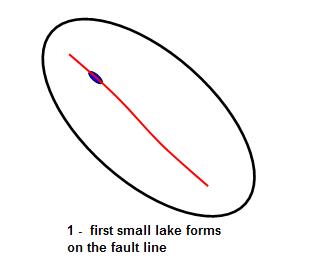

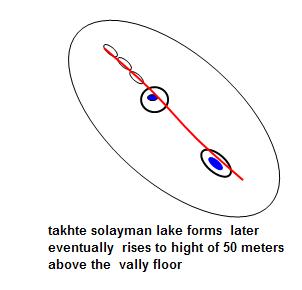




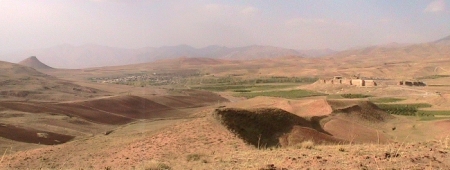


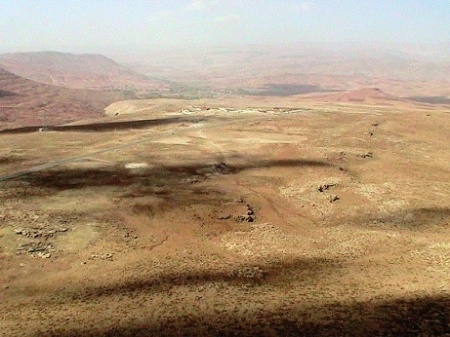

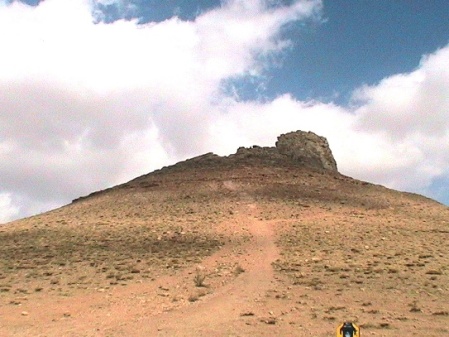



Leave a comment